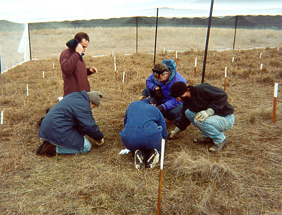Ecological Risk Assessment of GMOs

Over the past decade advances in molecular biology have made it possible to develop a wide range of genetically modified organisms (GMOs) that express a host of agriculturally beneficial traits. Currently, several genetically modified plants are grown in Australia (e.g., cotton), and many more have been developed for future use in Australian agriculture. Given that GMOs are likely to be used on a large scale, it is important to consider whether these plants pose any risks to native plant communities or ecosystems if they are released. As part of a more extensive ecological risk assessment program being undertaken within the CSIRO Biodiversity Sector, we are currently examining a range of ecological issues associated with the release of GM pasture plants.
The specific aims of this project are to: 1) determine whether genetically modified plants differ from commercial non-genetically modified strains in terms of growth, reproductive capability, ecological interactions or competitive ability, 2) understand the factors currently limiting the invasiveness of specific crop or pastoral plants in natural systems, and 3) determine whether these factors are altered in any significant way by the transgenes that are expressed by the genetically modified plants. Consideration of these issues will allow us to make informed decisions based on ecological principles regarding the level of risk posed by genetically modified plants to different native plant communities in Australia.
The research protocol consists of a range of field studies performed
in native communities and glasshouse experiments investigating the growth
and competitiveness of different GMOs under more controlled conditions.
We have focused much of our work on the pastoral plants Trifolium
subterraneum and Trifolium repens and their population dynamics
in native grasslands and grassy woodlands in southeast NSW. These species
are naturalized components of native plant communities in this region
and are also important components of grazed pastures across much of southern
Australia, and so are ideal species on which to perform our work.
Scientific Staff: Burdon, Godfree, Young
